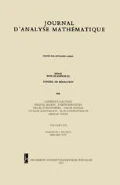Abstract
Baker and Montgomery have proved that almost all Fekete polynomials with respect to a certain ordering have at least one zero on the interval (0, 1). It is also known that a Fekete polynomial has no zeros on the interval (0, 1) if and only if the corresponding automorphic form is positive-definite. Generalizing their result, we formulate an axiomatic result about sets of automorphic forms π satisfying certain averages when suitably ordered to ensure that almost all p’s are not positive-definite within such sets. We then apply the result to various families, including the family of holomorphic cusp forms, the family of Hilbert class characters of imaginary quadratic fields, and the family of elliptic curves. In the appendix, we apply the result to general families of automorphic forms defined by Sarnak, Shin, and Templer.
Similar content being viewed by others
References
J. Arthur, The Endoscopic Classification of Representations: Orthogonal and Symplectic Groups, American Mathematical Society, Providence, RI, 2013.
E. Bachmat, Mathematical Adventures in Performance Analysis, Birkhäuser/Springer, 2014.
R C. Baker and H. L. Montgomery, Oscillations of quadratic L-functions, in Analytic Number Theory, Birkhäuser Boston, Boston, MA, 1990, pp. 23–40.
N. Bergeron, J. Millson, and C. Moeglin, Hodge type theorems for arithmetic manifolds associated to orthogonal groups,arXiv:1110.3049v3[math. NT].
B. J. Birch, How the number of points of an elliptic curve over a fixed prime field varies, J. London Math. Soc., 43 (1968), 57–60.
B. J. Birch and H. P. F. Swinnerton-Dyer, Notes on elliptic curves. II, J. Reine Angew. Math., 213(1965), 79–108.
E. Bombieri, A variational approach to the explicit formula, Comm. Pure Appl. Math. 56 (2003), 1151–1164.
A. Borel, Automorphic L-functions, in Automorphic forms, Representations and Lfunctions, American Mathematical Society, Providence, RI, 1979, pp. 27–61.
C. Breuil, B. Conrad, F. Diamond, and R. Taylor, On the modularity of elliptic curves over Q: wild 3-adic exercises, J. Amer. Math. Soc., 14 (2001), 843–939.
P. Cartier, Representations of p-adic groups: A survey, in Automorphic Forms, Representations and L-functions, American Mathematical Society, Providence, RI, 1979, pp. 111–155.
S. Chowla, Note on Dirichlet’s L-functions, Acta. Arith., 1 (1935), 113–114.
R. Courant, Ein allgemeiner satz zur theorie der eigenfunktionen selbstadjungierter differentialausdr ücke, Nachr. Ges. Wiss. Göttingen (1923), 81–84.
B. Conrey, A. Granville, B. Poonen, and K. Soundararajan, Zeros of Fekete polynomials, Ann. Inst. Fourier (Grenoble), 50 (2000), 865–889.
C. Hamer, A formula for the traces of the Hecke operators on certain spaces of newforms, Arch. Math. (Basel) 70 (1998), 204–210.
H. Heilbronn, On real characters, Acta Arith., 2 (1937), 212–213.
H. Jacquet and J. A. Shalika, On Euler products and the classification of automorphic forms II, Amer. J. Math., 103 (1981), 777–815.
S. Karlin, Total Positivity, Vol. I, Stanford University Press, Stanford, CA, 1968.
S. Kato, Spherical functions and a q-analogue of Kostant’s weight multiplicity formula, Invent. Math., 66 (1982), 461–468.
N. M. Katz, Exponential sums over finite fields and differential equations over the complex numbers: some interactions, Bull. Amer. Math. Soc. (N. S.), 23 (1990), 269–309.
M. A. Kenku, On the number of Q-isomorphism classes of elliptic curves in each Qisogeny class, J. Number Theory, 15 (1982), 199–202.
H. H. Kim and F. Shahidi, Functorial products for GL2 × GL3 and functorial symmetric cube for GL2, C. R. Acad. Sci. Paris Sér. I Math., 331 (2000), 599–604.
N. N. Lebedev, Special Functions and their Applications, revised English edition, Prentice-Hall Inc., Englewood Cliffs, NJ, 1965.
W. Luo, Z. Rudnick, and P. Sarnak, On the generalized Ramanujan conjecture for GL(n), in Automorphic Forms, Automorphic Representations, and Arithmetic, Amer. Math. Soc., Providence, RI, 1999, pp. 301–310.
G. Martin, Dimensions of the spaces of cusp forms and newforms on 0(N) and 1(N), J. Number Theory, 112 (2005), 298–331.
F. Mertens, Ein beitrag zur analytischen zahlentheorie. Ueber die vertheilung der primzahlen, J. Reine Angew. Math., 78 (1874), 44–63.
C. P. Mok, C. P. Mok, Endoscopic classification of representation of quasi-split arbitrary groups, Mem. Amer. Math. Soc., 235 (2015), no. 108.
H. Montgomery and R. C. Vaughan, Multiplicative Number Theory I. Classical theory, Cambridge University Press, Cambridge, 2007.
G. Polya, Verschiedene Bemerkungen zur Zahlentheorie, Jahresber. Dtsch. Math. Ver., 28 (1919), 31–40.
P. Sarnak, Class numbers of indefinite binary quadratic forms. II, J. Number Theory, 21 (1985), 333–346.
P. Sarnak, Letter to Eitan Bachmat on positive definite L-functions, publications.ias.edu/sarnak/paper/511.
P. Sarnak, S. W. Shin, and N. Templier, Families of L-functions and their symmetry, Proceedings of the Simons Symposion on Families of Automorphic Forms and the Trace Formula, January 26 February 1, 2014.
C. L. Siegel, Uber die Classenzahl quadratischer Zahlkörper, Acta. Arith., 1 (1935), 83–86.
A. Selberg, On the Estimation of Fourier Coefficients of Modular Forms, American Mathematical Society, Providence, RI, 1965.
J.-P. Serre, Répartition asymptotique des valeurs propres de l’opérateur de Hecke Tp, J. Amer. Math. Soc. 10 (1997), 75–102.
S. W. Shin and N. Templier, Sato-Tate theorem for families and low-lying zeros of automorphic L-functions, Invent. Math., 203 (2016), 1–177.
Author information
Authors and Affiliations
Corresponding author
Additional information
This work was supported by the National Research Foundation of Korea(NRF) grant funded by the Korea government(MSIP)(No. 2013042157). The author was also partially supported by NSF grant DMS-1128155 and by TJ Park Post-doc Fellowship funded by POSCO TJ Park Foundation.
Rights and permissions
About this article
Cite this article
Jung, J., Shin, S.W. On the sparsity of positive-definite automorphic forms within a family. JAMA 129, 105–138 (2016). https://doi.org/10.1007/s11854-016-0017-9
Received:
Revised:
Published:
Issue Date:
DOI: https://doi.org/10.1007/s11854-016-0017-9




